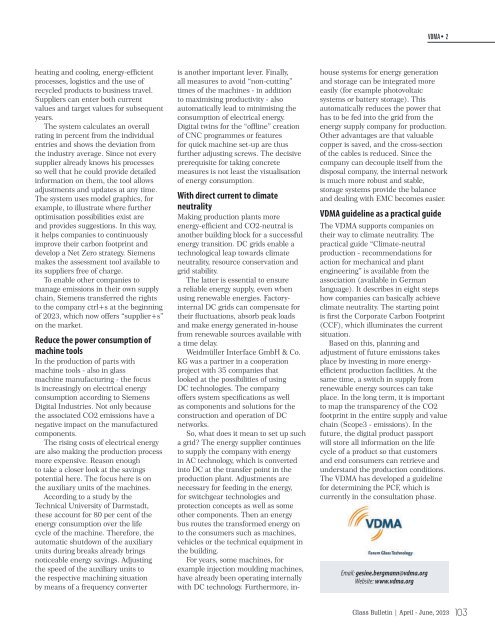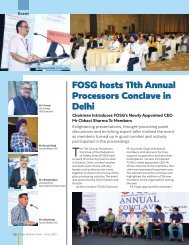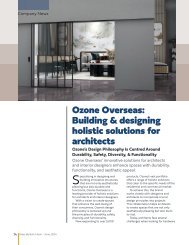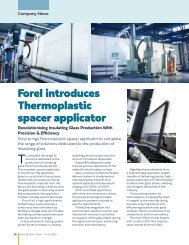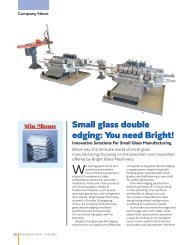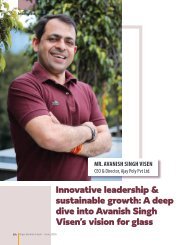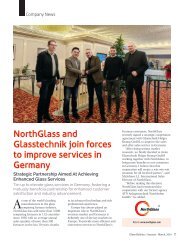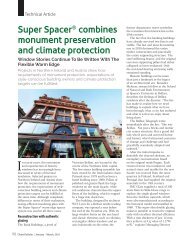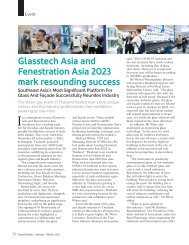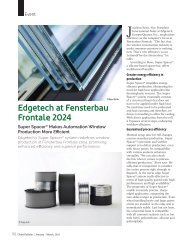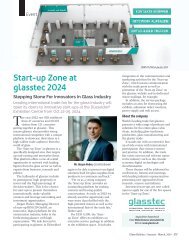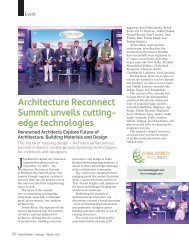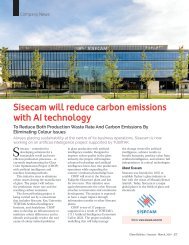Edition 70 (April-June, 2023)
Create successful ePaper yourself
Turn your PDF publications into a flip-book with our unique Google optimized e-Paper software.
VDMA• 2<br />
heating and cooling, energy-efficient<br />
processes, logistics and the use of<br />
recycled products to business travel.<br />
Suppliers can enter both current<br />
values and target values for subsequent<br />
years.<br />
The system calculates an overall<br />
rating in percent from the individual<br />
entries and shows the deviation from<br />
the industry average. Since not every<br />
supplier already knows his processes<br />
so well that he could provide detailed<br />
information on them, the tool allows<br />
adjustments and updates at any time.<br />
The system uses model graphics, for<br />
example, to illustrate where further<br />
optimisation possibilities exist are<br />
and provides suggestions. In this way,<br />
it helps companies to continuously<br />
improve their carbon footprint and<br />
develop a Net Zero strategy. Siemens<br />
makes the assessment tool available to<br />
its suppliers free of charge.<br />
To enable other companies to<br />
manage emissions in their own supply<br />
chain, Siemens transferred the rights<br />
to the company ctrl+s at the beginning<br />
of <strong>2023</strong>, which now offers “supplier+s”<br />
on the market.<br />
Reduce the power consumption of<br />
machine tools<br />
In the production of parts with<br />
machine tools - also in glass<br />
machine manufacturing - the focus<br />
is increasingly on electrical energy<br />
consumption according to Siemens<br />
Digital Industries. Not only because<br />
the associated CO2 emissions have a<br />
negative impact on the manufactured<br />
components.<br />
The rising costs of electrical energy<br />
are also making the production process<br />
more expensive. Reason enough<br />
to take a closer look at the savings<br />
potential here. The focus here is on<br />
the auxiliary units of the machines.<br />
According to a study by the<br />
Technical University of Darmstadt,<br />
these account for 80 per cent of the<br />
energy consumption over the life<br />
cycle of the machine. Therefore, the<br />
automatic shutdown of the auxiliary<br />
units during breaks already brings<br />
noticeable energy savings. Adjusting<br />
the speed of the auxiliary units to<br />
the respective machining situation<br />
by means of a frequency converter<br />
is another important lever. Finally,<br />
all measures to avoid “non-cutting”<br />
times of the machines - in addition<br />
to maximising productivity - also<br />
automatically lead to minimising the<br />
consumption of electrical energy.<br />
Digital twins for the “offline” creation<br />
of CNC programmes or features<br />
for quick machine set-up are thus<br />
further adjusting screws. The decisive<br />
prerequisite for taking concrete<br />
measures is not least the visualisation<br />
of energy consumption.<br />
With direct current to climate<br />
neutrality<br />
Making production plants more<br />
energy-efficient and CO2-neutral is<br />
another building block for a successful<br />
energy transition. DC grids enable a<br />
technological leap towards climate<br />
neutrality, resource conservation and<br />
grid stability.<br />
The latter is essential to ensure<br />
a reliable energy supply, even when<br />
using renewable energies. Factoryinternal<br />
DC grids can compensate for<br />
their fluctuations, absorb peak loads<br />
and make energy generated in-house<br />
from renewable sources available with<br />
a time delay.<br />
Weidmüller Interface GmbH & Co.<br />
KG was a partner in a cooperation<br />
project with 35 companies that<br />
looked at the possibilities of using<br />
DC technologies. The company<br />
offers system specifications as well<br />
as components and solutions for the<br />
construction and operation of DC<br />
networks.<br />
So, what does it mean to set up such<br />
a grid? The energy supplier continues<br />
to supply the company with energy<br />
in AC technology, which is converted<br />
into DC at the transfer point in the<br />
production plant. Adjustments are<br />
necessary for feeding in the energy,<br />
for switchgear technologies and<br />
protection concepts as well as some<br />
other components. Then an energy<br />
bus routes the transformed energy on<br />
to the consumers such as machines,<br />
vehicles or the technical equipment in<br />
the building.<br />
For years, some machines, for<br />
example injection moulding machines,<br />
have already been operating internally<br />
with DC technology. Furthermore, inhouse<br />
systems for energy generation<br />
and storage can be integrated more<br />
easily (for example photovoltaic<br />
systems or battery storage). This<br />
automatically reduces the power that<br />
has to be fed into the grid from the<br />
energy supply company for production.<br />
Other advantages are that valuable<br />
copper is saved, and the cross-section<br />
of the cables is reduced. Since the<br />
company can decouple itself from the<br />
disposal company, the internal network<br />
is much more robust and stable,<br />
storage systems provide the balance<br />
and dealing with EMC becomes easier.<br />
VDMA guideline as a practical guide<br />
The VDMA supports companies on<br />
their way to climate neutrality. The<br />
practical guide “Climate-neutral<br />
production - recommendations for<br />
action for mechanical and plant<br />
engineering” is available from the<br />
association (available in German<br />
language). It describes in eight steps<br />
how companies can basically achieve<br />
climate neutrality. The starting point<br />
is first the Corporate Carbon Footprint<br />
(CCF), which illuminates the current<br />
situation.<br />
Based on this, planning and<br />
adjustment of future emissions takes<br />
place by investing in more energyefficient<br />
production facilities. At the<br />
same time, a switch in supply from<br />
renewable energy sources can take<br />
place. In the long term, it is important<br />
to map the transparency of the CO2<br />
footprint in the entire supply and value<br />
chain (Scope3 - emissions). In the<br />
future, the digital product passport<br />
will store all information on the life<br />
cycle of a product so that customers<br />
and end consumers can retrieve and<br />
understand the production conditions.<br />
The VDMA has developed a guideline<br />
for determining the PCF, which is<br />
currently in the consultation phase.<br />
Email: gesine.bergmann@vdma.org<br />
Website: www.vdma.org<br />
Glass Bulletin | <strong>April</strong> - <strong>June</strong>, <strong>2023</strong> 103


